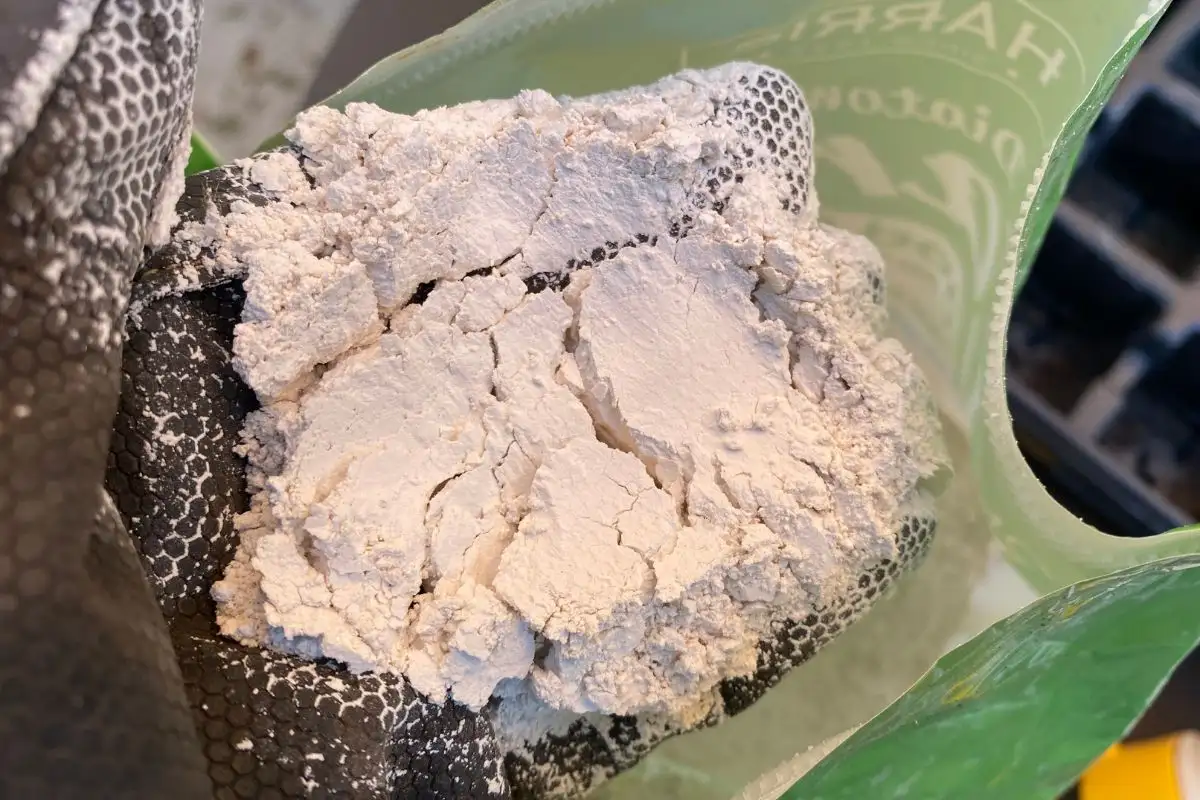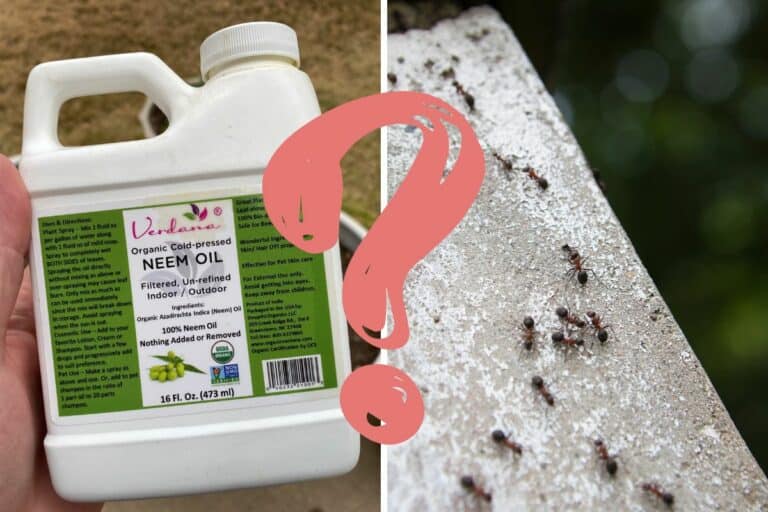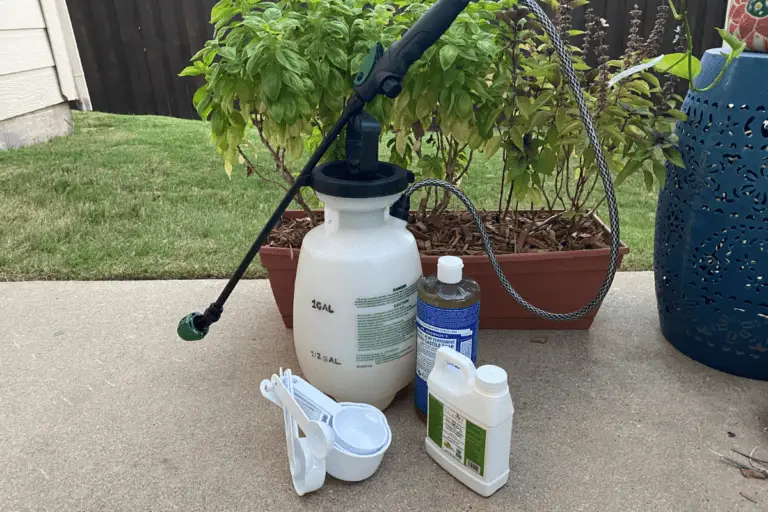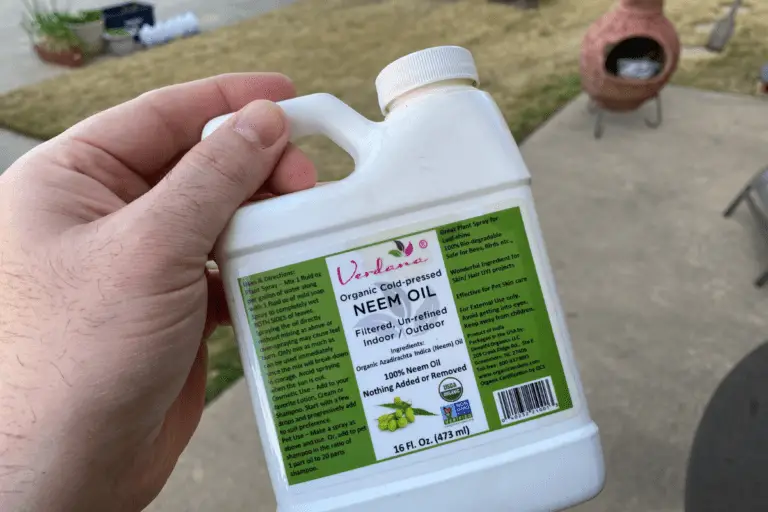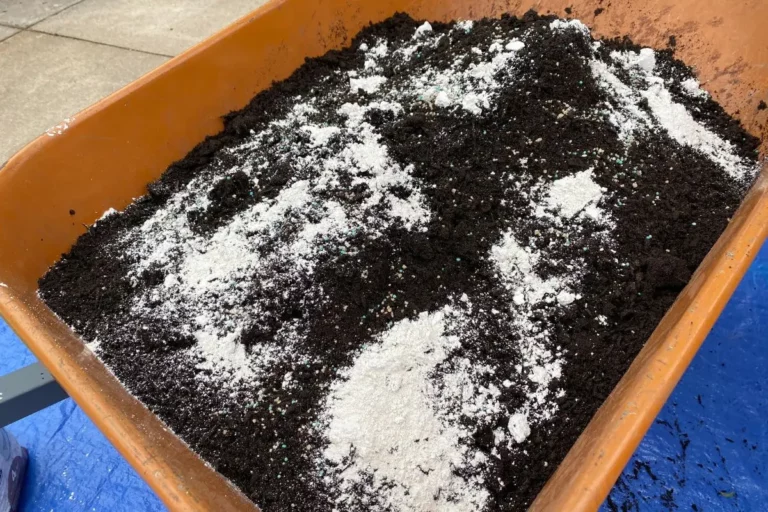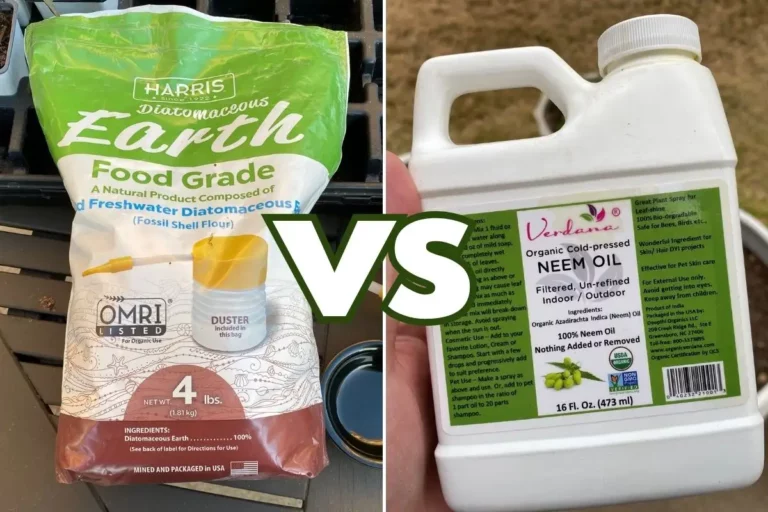Can Diatomaceous Earth Harm Plants? What Scientists Say
I like to avoid using unnecessary chemicals in my garden, which is why I’m always on the lookout for natural solutions to bug infestations. One product that I’ve started using regularly is diatomaceous earth, or DE for short.
If you’ve picked up a bag of DE, you might be wondering: Is it safe for plants?
I’ll cover what the research says in the article below, but here’s the short answer:
Diatomaceous earth is a natural, non-toxic substance that won’t harm plants when used properly. Derived from the fossilized shells of single-celled algae, diatomaceous earth has sharp, microscopic edges that’ll kill off insects, but these particles are too small to cause damage to plant tissue.
However, I saw several websites that raised concerns about widespread DE usage and its potential impact on garden plants–citing everything from chlorophyll reduction to stomata blockages to the killing off of beneficial pollinators–so I wanted to dig a bit deeper to make sure that DE was a good choice for my garden.
(And wow, I’m glad I did! More on that below)
In this article, I’ll cover the following topics for anyone who’d like to learn more about using DE in the garden:
- what DE is and how it works.
- what DE does to plants, pests, and beneficial bugs.
- tips for using DE effectively in your garden.
Diatomaceous earth is an incredible natural insecticide, but if you’re not careful with it, you can overdo things (and even harm yourself in the process!).
But if you take some time to learn how to work with DE (and you follow the proper precautions), diatomaceous earth can be a powerful tool for getting rid of unwanted garden pests.
With that being said, let’s dive deeper into the effects of DE on plants and the best ways to use it in your garden.
What Does Diatomaceous Earth Do to Pests and Plants?
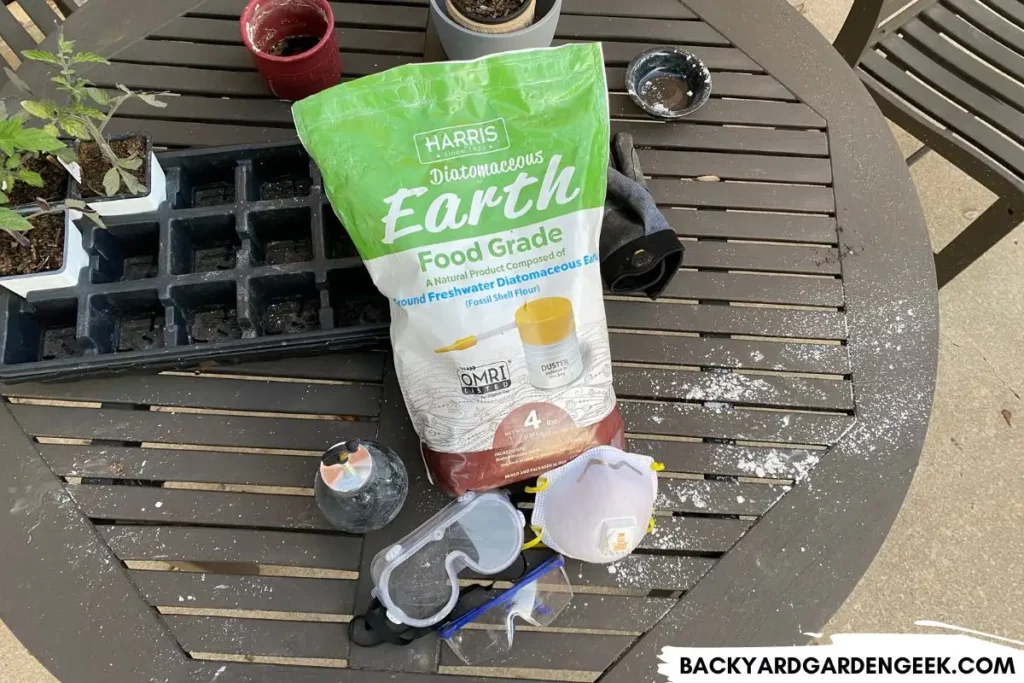
This post may contain affiliate links. Please see my disclosure to learn about the care I take when recommending products to my readers.
As I noted earlier, diatomaceous earth consists of the fossilized remnants of tiny aquatic organisms.
They’re called diatoms, and these little members of the plankton family are fascinating. In fact, scientists have no idea how many diatom species are out there. There could be as few as 20,000 species or up to several million of them!
But we do know this: Diatoms are the only species on earth with cellular walls made up entirely of silica. Once fossilized, the ground-up shells of diatoms are transformed into diatomaceous earth, a powdery substance that’s harmless to humans and all other mammals but deadly to insects and other arthropods due to its sharp, microscopic particles.
When insects come into direct contact with DE, they’ll dehydrate and die as the DE absorbs the waxy outer layer of their exoskeletons. In fact, if it doesn’t kill insects through dehydration, DE’s small abrasive particles can cause damage by cutting into insects’ bodies.
This is why DE is effective against a wide range of pests, including ants, aphids, bedbugs, cockroaches, fleas, mites, and many others.
However, the qualities of DE that harm insects cause no problems in plants for several reasons.
- First, although DE can penetrate insect exoskeletons, its particles are too small to cause any cellular damage to plants. It’ll coat the leaves, flowers, and stems in a powdery dust, but it won’t hurt the plant.
- Second, plants have a waxy protective outer layer called a cuticle that prevents DE from causing any damage to the plant’s leaves, flowers, or stems.
- Third, that same waxy layer serves as a barrier that prevents moisture loss, which helps plants avoid the dehydration that kills off insects.
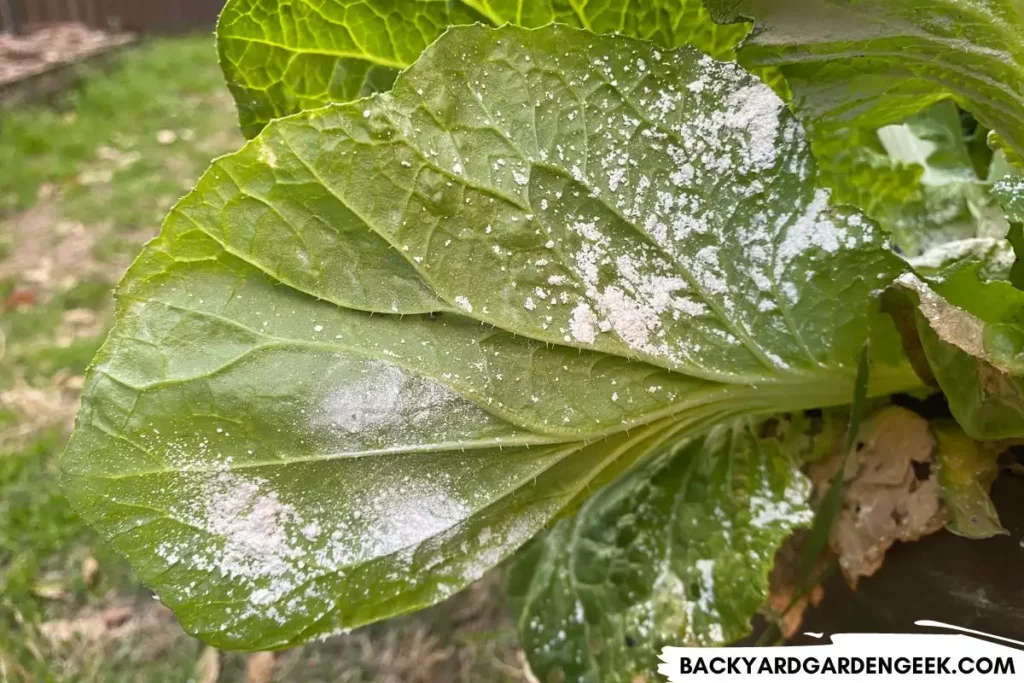
Despite these protective mechanisms, I’ve seen a few studies that suggest that DE can have some negative side effects on plants by reducing chlorophyll or harming beneficial insects.
But from what I’ve seen from the research (as well as my own personal experiences using DE in my garden), I don’t really trust such claims since there are various competing studies that seem to contradict or say otherwise.
Here’s what I’ve found so far:
- A 2016 study that looked at DE use against wheat aphids found that using DE in conjunction with foliar sprays led to a decrease in plants’ chlorophyll production while not killing off wheat aphids. This is the only paper I’ve seen that suggests DE reduces chlorophyll levels in plants.
- Back in 2007, a team of researchers looked at using DE in conjunction with neem oil and found that it actually increased chlorophyll levels in artichoke plants since it killed off a significant number of aphids.
- A 2017 paper substantiated this claim by showing that chlorophyll levels in pomegranates increased when DE was used as a pest management method.
- Another study from 2017 looked at tomato yields and suggested that DE might slightly speed up the maturing process (although I have my doubts about this study).
- In 2021, a study showed that DE increased photosynthesis by killing pink stem borers that were causing damage to wheat harvest.
I’ve seen a few bloggers discuss the possibility of DE clogging up plant stomata and thus hindering the plant’s ability to take up carbon dioxide, but I’ve seen no scientific research to back up such claims.
Given the research that’s out there at present, I feel comfortable using diatomaceous earth selectively in my garden since I’m not worried that it’ll somehow damage my plants.
I say “selectively” since I’m very careful with DE. I don’t just cover my plants in it, nor do I spray it whenever I see any signs of garden pests.
If you’d like to learn more about what I do when I first see signs of an infestation, please check out these articles:
- Can Plants Recover from Spider Mites? What You Need to Know
- How Can I Make Neem Oil More Effective? My 10-Step Process
- How Long Does It Take for Neem Oil to Kill Bugs?
- Where Do Spider Mites Come From? What Science Has to Say
- Using Neem Oil Before a Harvest: The Do’s and Don’ts
More importantly, I’d like to share a few pointers when it comes to using DE safely and effectively, so please look below for my DE application tips.
Protect Your Plants with Diatomaceous Earth: Tips for Safe Application
If you’re planning to use DE in your garden this year, you’ll want to consider several things before you buy something at your local garden center or home improvement store and start using it around your property.
Here’s a quick overview of the most important things to keep in mind when using DE on your plants. (Don’t worry. I’ll explain everything in more detail below!)
- Use food-grade diatomaceous earth.
- Only use DE when it’s dry outside.
- Apply a thin, powdery layer to plants.
- Reapply after rain or very high humidity levels.
- Wear a face mask and goggles when applying.
- Keep away from pollinators.
- Consider the time of day.
- Store DE correctly.
Use Food-Grade Diatomaceous Earth
Diatomaceous earth comes in two forms, food-grade and industrial grade (sometimes referred to as pool grade or filter grade due to its many commercial uses).
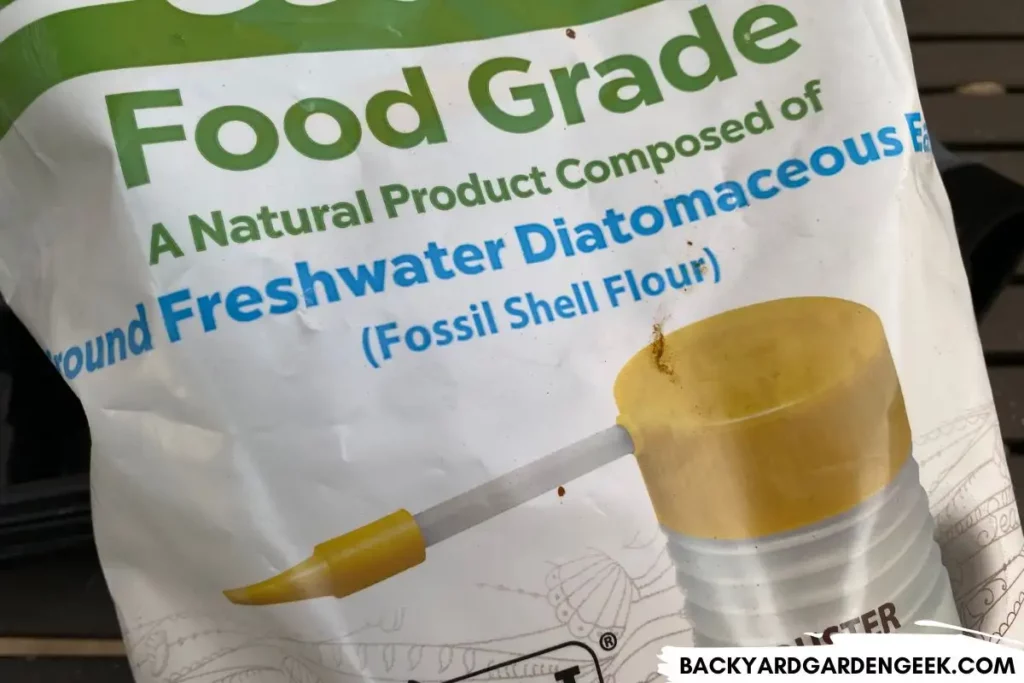
Food-grade diatomaceous earth is what you want! It’s safe for humans, pets, and plants. You’ll want to avoid the other kind since that diatomaceous earth is chemically treated and can be harmful to your garden.
When you purchase your product, look for a label that specifies food-grade, and check that the product is registered with the Environmental Protection Agency (EPA).
I’ve had lots of success with Harris Diatomaceous Earth. It even comes with a plastic powder duster (more on that below).
Apply in Dry Weather
Diatomaceous earth works best in dry conditions since moisture of any kind will cause the silica shells to absorb moisture and clump together, which will drastically reduce its effectiveness.
Here’s what you should do: Wait for a dry day, then apply diatomaceous earth to your garden. If you apply it before or during wet weather, you’ll just have to reapply it once everything dries out.
Apply a Light Layer
Diatomaceous earth should be applied in thin layers. Don’t cake your plants in it since too much DE earth can actually prevent plants from getting the sunlight they need to thrive.
You can apply DE using a powder duster or by hand, but I personally prefer to use a powder duster since you’ll end up wasting lots of DE if you’re sticking your hand in the bag and tossing it on or around your plants.
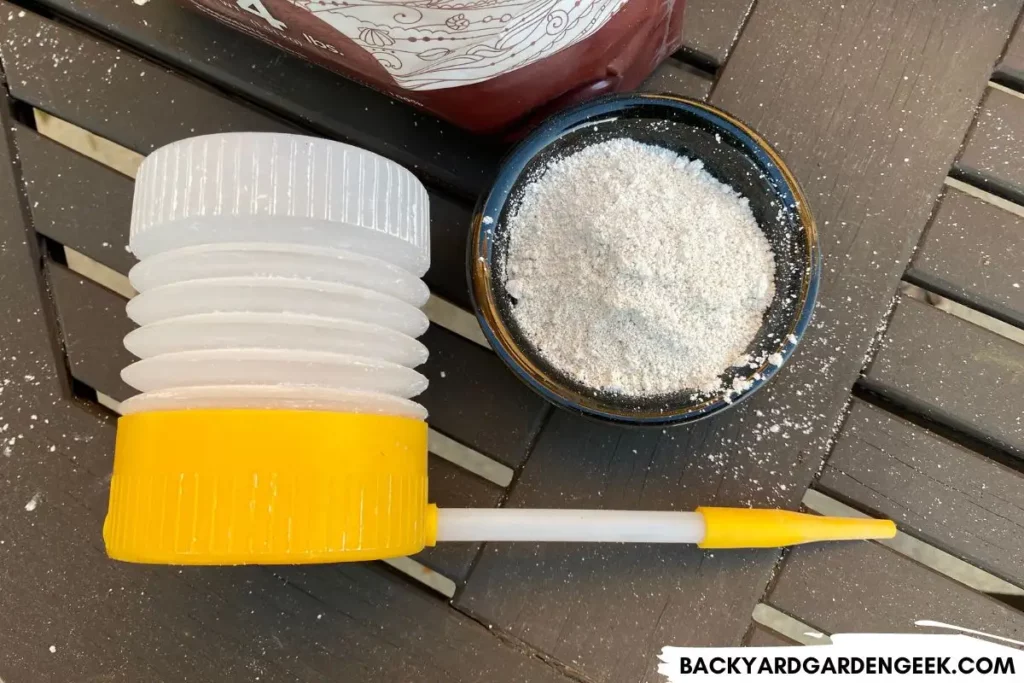
Reapply After Rain
If you’ve got DE on your plants before a storm arrives, that’s no big deal. It just means you’ll have to reapply it again after everything’s dry.
Keep an eye on the weather and don’t apply DE to your plants if you see any storm predictions for the next few days.
Wear Protective Gear
The first time I used diatomaceous earth, I didn’t give a second thought to protective gear. I simply aimed my powder duster at the plant and dispersed the DE.
Unfortunately, I hadn’t considered the wind, and next thing I knew, I was surrounded by a cloud of DE. I closed my eyes and mouth and ran away from the area, but that was enough to teach me to never apply DE without something covering my eyes and mouth.
DE won’t hurt you unless you inhale lots of it, but it can definitely be irritating to your skin and eyes, so always be sure to wear protective gear when applying it.
When I use it, I wear gloves to protect my hands, a face mask to avoid inhaling any of it, and glasses or safety goggles to keep it out of my eyes.
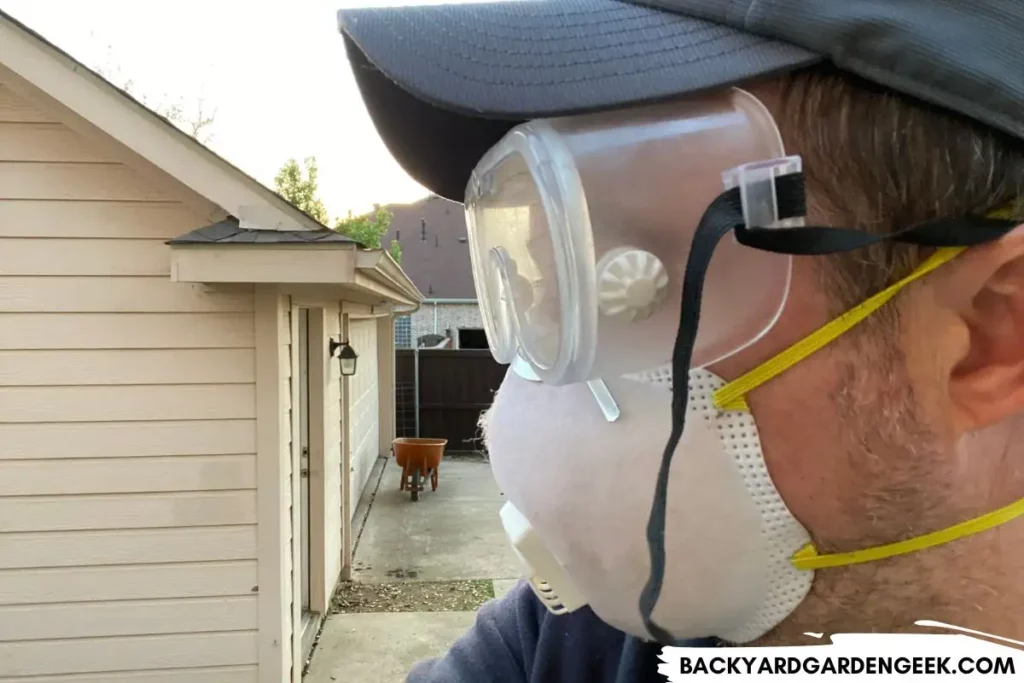
If you accidentally get DE on your skin or in your eyes, don’t fret. Just rinse everything thoroughly with water.
Avoid Applying Near Pollinators
Generally speaking, you don’t want to be dusting your plants if there are pollinators around or if pollinators are likely to visit the plants any time soon when it’s flowering.
Little research exists about the impact of DE on pollinators, but one study suggested that DE could increase mortality rates in honeybees and bumblebees, albeit at a level that wasn’t too alarming to the researchers.
Because of that, I suggest using caution when applying DE to your plants. Focus on areas where pests are likely to be present, such as the leaves or stems, and be sure to dust your plants later in the day (or early evening) since most pollinators will not be active during that time.
If you’re open to using neem oil this year, I’ve found that it’s very pollinator friendly (as long as you don’t spray them directly with it). Here are a few articles that explain how I use neem oil in my garden:
- Can You Use Too Much Neem Oil on Plants?
- Don’t Use Neem Oil on These Garden Plants
- Why Do Insects Hate Neem Oil? 12 Secrets to Its Success
- Will Neem Oil Kill Ladybugs? Here’s What You Need to Know
- Will Neem Oil Kill Pollinators or Other Beneficial Insects?
Consider the Time of Day
Diatomaceous earth is most effective when applied in the early evening, when pests are present but pollinators have largely taken a break.
I like applying DE in tandem with soapy water or neem oil, especially if I’m dealing with an infestation of aphids or spider mites (my personal nemeses!). But you’ve got to be careful since you don’t want to wet down your DE in any way.
Here’s what I do when I want to use soapy water or neem oil alongside DE:
- On Day 1, I wait until 6pm or so (when the sun’s still out but it’s getting close to sunset), then I apply a soapy water or neem oil spray to my plants. My articles on helping plants recover from aphids and using neem oil to kill spider mites explain my method in detail, so check those out if you want to learn more.
- On Day 2, I’ll dust the problem areas with a light layer of DE, using a powder duster. The plastic powder duster that comes with the Harris Diatomaceous Earth is just fine, but it’s not the most reliable duster out there. I much prefer Dr. Killigan’s Bulb Duster. It’s a little pricey, but the quality is great, and it’s a much more reliable powder duster.
Again, don’t dust your plants with DE, then spray them with soapy water or neem oil. You’ll end up rendering the DE completely ineffective.
Store Diatomaceous Earth Correctly
To ensure that your DE stays effective for as long as possible, store it in a cool, dry place. Don’t let it get anywhere near moisture!
Airtight containers or resealable bags are just fine. The bag your DE comes in might just be the self-sealing kind, much like the Harris brand that I’ve come to like.
If you’re storing DE in a container or bag, make sure to label it correctly and note the date you purchased it so that you can keep track of things. DE doesn’t expire, but there’s no real benefit to long-term storage.
The key with diatomaceous earth is patience, but if you want to see the best results, use it in tandem with soapy water or neem oil sprays (or all 3 if you’ve got a nasty infestation of some kind!).
As long as you’re patient and persistent with your applications, you’ll likely see results over time since ants, aphids, armyworms, spider mites, stink bugs, and other garden pests will have a hard time against a multi-pronged pest management strategy.
Additional Information
If you’re looking to tackle pest problems in your garden, you might be interested in these articles:
- 27 Plants that Resist, Repel, and Trap Spider Mites
- Can You See Aphids on Plants? Spotting Early Infestations
- Do Ants Make Aphids Worse? 7 Behaviors to Understand
- Should I Throw Away a Plant with Aphids? Things to Consider
- What Do Spider Mites Look Like on Plants? (Photos + Video)
- Will Neem Oil Kill or Repel Ants? All You Need to Know
